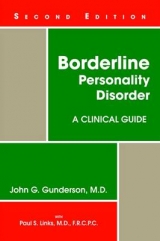
Borderline Personality Disorder
American Psychiatric Press Inc. (Verlag)
978-1-58562-016-6 (ISBN)
- Titel erscheint in neuer Auflage
- Artikel merken
Borderline personality disorder is easily the most widely and commonly used diagnosis for personality disorders in clinical practice todayAaffecting about 2%A3% of the general population, 25% of the inpatient population, and 15% of the outpatient population. This sequel to GundersonAs 1984 Borderline Personality Disorder reflects the explosion of information, expertise, and specialization in borderline personality disorder, covering all recognized treatments for the clinical care of borderline patients in todayAs managed care environment. Integrating scientific advances with clinical lore, it offers a sophisticatedAand uniquely comprehensiveAlook at treatment literature, clinical perspectives, and modalities. Beginning with the diagnosis itself (with special attention to the borderline patientAs specialty, self-destructiveness), this remarkable volume presents the following topics: -The authorAs empirically and clinically anchored theory on the sequencing of goals (i.e., the targets for intervention), processes of change, and modalities best suited for a patientAs changing needs.
This theory superimposes a logic on treatment planning and anticipates the sequence of subsequent chapters on specific treatment modalities. -The importance of the primary clinician, easily overlooked because borderline patients receive care in multiple settings, further complicating the already difficult process of obtaining the critical treatment authorizations mandated by managed care. Treatment split among caregivers, made necessary by todayAs managed care environment, is here elevated to a virtue because multiple caregivers add breadth to treatment goals and help prevent flight from treatment by these patients. -The different goals, directions, structure, and staffing of the four levels of care: hospitalization, residential/partial hospital care, intensive outpatient programs, and outpatient programs.
-Two seemingly conflicting aspects of psychopharmacology: 1) a guide to selecting medication (the single most widely and uniformly used treatment), and 2) the real-life complexities of prescribing medications and evaluating their effectiveness -Cognitive-behavioral therapies (the major therapeutic advance of the 1990s), especially dialectical behavior therapy; family involvement; and interpersonal group treatment. -An in-depth exploration of psychoanalytic psychotherapy, in which the author argues that this modality (until recently, the treatment of choice for borderline patients) should be used selectively because of the motivation and aptitude required by both patients and therapists. Enhanced by both case reports and sidebars that detail newsworthy, timelyAand controversialAtopics found nowhere else in the literature, this captivating text concludes with a refreshingly optimistic look at the future of effectively treating borderline patients. It will prove an invaluable reference for clinicians, patientsA families, health care administrators, and instructors in psychotherapy, psychopathology, and integrated treatment.
John G. Gunderson, M.D., is Professor of Psychiatry at Harvard Medical School and Director of Psychosocial and Personality Research and Chief of Ambulatory Personality Disorder Services at McLean Hospital, Belmont, Massachusetts. He has worked in the diagnostic and treatment of borderline patients since 1969, including carrying out important studies helping to define the diagnosis and differentiate it from other disorders. He continues to work in advancing effective treatments today.
Preface. Introduction. The borderline diagnosis. Differential diagnosis: overlaps, subleties, and treatment implications. Overview of treatment. Case management: the primary clinician. Levels of care: indications, structure, staffing. Pharmacotherapy: clinical practices. Pharmacotherapy: selection of medications. Cognitive/behavioral therapies: dialectical behavior therapy, cognitive therapies and psychoeducation. Family therapies. Interpersonal group therapy. Individual psychotherapies: phase 1: getting started. Individual psychotherapies, phase 2, 3, 4: processes of change. Future considerations. Index.
| Erscheint lt. Verlag | 1.3.2001 |
|---|---|
| Zusatzinfo | index |
| Verlagsort | VA |
| Sprache | englisch |
| Maße | 159 x 229 mm |
| Gewicht | 703 g |
| Themenwelt | Medizin / Pharmazie ► Medizinische Fachgebiete ► Psychiatrie / Psychotherapie |
| ISBN-10 | 1-58562-016-5 / 1585620165 |
| ISBN-13 | 978-1-58562-016-6 / 9781585620166 |
| Zustand | Neuware |
| Haben Sie eine Frage zum Produkt? |
aus dem Bereich



